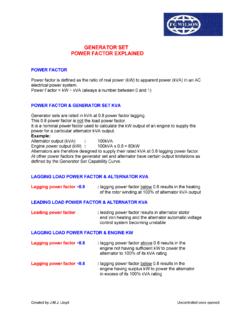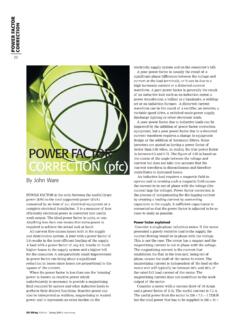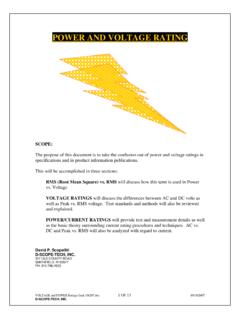Transcription of Understanding the Wind Power Equation - SolidWize
1 WindPitch Experiments for the Blade Design and Performance Kit Copyright ecoCAD Design Group, LLC 2011 all rights reserved 42 Understanding the wind Power Equation EXPERIMENT OVERVIEW This is not an experiment but rather an explanation of the wind Power Equation . In preparation to perform the Power and Efficiency experiment, students will become familiar with the wind Power Equation and how wind speed, blade area and other factors influence the electrical Power output of the WindPitch wind turbine.
2 EXPERIMENT OBJECTIVES Students will use the Scientific Process to perform the experiment. Students will understand the primary elements of the wind Power Equation . THE wind Power Equation The wind Power Equation is expressed as follows: P = * *A*V *E Where: P = Power in Watts = Air Density in Kg/m (about at sea level, less higher up) A = Rotor Swept Area in m = r (r= radius or blade length) V = wind Speed in m/s (cubed) E = Efficiency in percent WindPitch Experiments for the Blade Design and Performance Kit Copyright ecoCAD Design Group, LLC 2011 all rights reserved 43 The following is a general explanation of each variable and what it means to the output Power from any given wind turbine.
3 P The symbol P stands for electrical Power in watts. This is measured by the electronics on the Control Panel and displayed on the PC software. After the equal (=) sign the value is a close approximation of the Betz Limit, which implies that the maximum amount of Power that can be derived from the wind amounts to about one-half of the Power in the wind itself. Refer to the following page for more information on the Betz Limit. The lower case Greek symbol rho ( ) represents the air density in kilograms per meter squared (Kg/m2).
4 While it is a minor contributor to the overall wind Power level it can make a significant difference if the wind turbine is at a very high altitude like on a mountain peak where the air density is low. Refer to the next page for a convenient means to determine air density. A The rotor swept blade area is a significant contributor to wind turbine Power production. As the Equation indicates the Power (P) varies as the square of the swept area. This means that doubling the amount of swept area will (theoretically) quadruple ( P x 4) the output Power .
5 Conversely, halving the rotor swept blade area will reduce the output Power to one-forth (P / 4). It should be mentioned that the rotor swept blade area DOES NOT mean increasing the number of blades. It only means the circular area that is swept by the rotating blades themselves be it 2, 3, 4, 6 or even 1 blade. V The wind speed itself determines a large part of the Power production. As the Equation indicates the Power (P) varies as the cube of the wind speed. This means that doubling the wind speed will (theoretically) multiply the Power by eight times (P x 8).
6 Conversely, halving the wind speed will reduce the Power output to one-eight (P/8) of the previous wind speed value. E wind turbine efficiency is expressed by the symbol E. Efficiency can be expressed as a multitude of sub-variables that are beyond the scope of this writing; however, it can take in things like blade design, wind resistance and turbulence, wind turbine tower height, wind flow around the blades and tower and other factors some of which are explained next along with the Betz Limit.
7 WindPitch Experiments for the Blade Design and Performance Kit Copyright ecoCAD Design Group, LLC 2011 all rights reserved 44 BETZ LIMIT Albert Betz was a German physicist who in 1919 concluded that no wind turbine can convert more than 16/27 ( ) of the kinetic energy of the wind into mechanical energy turning a rotor. To this day this is known as the Betz Limit or Betz' Law. This limit has nothing to do with inefficiencies in the generator, but in the very nature of wind turbines themselves. wind turbines extract energy by slowing down the wind .
8 For a wind turbine to be 100% efficient it would need to stop 100% of the wind - but then the rotor would have to be a solid disk and it would not turn and no kinetic energy would be converted. On the other extreme, if you had a wind turbine with just one rotor blade, most of the wind passing through the area swept by the turbine blade would miss the blade completely and so most of the kinetic energy would remain with the wind and not be transferred to the wind turbine s electrical generator. REAL WORLD wind TURBINE EFFICIENCIES According to the Betz Limit the theoretical maximum Power efficiency of any design of wind turbine is ( no more than 59% of the energy carried by the wind can be extracted by a wind turbine).
9 Once you also factor in the engineering requirements of a wind turbine - strength and durability in particular - the real world limit is well below the Betz Limit with values of common even in the best designed wind turbines. By the time other ineffiencies in a complete wind turbine system are taken into account - the generator, bearings, Power transmission and so on - only 10-30% of the Power of the wind is ever actually converted into usable electricity. (see the graphic above from the Iowa Energy Center, USA.)
10 Horizontal axis wind turbines (HAWT) theoretically have higher Power efficiencies than vertical axis wind turbines (VAWT) however wind direction is not important for a VAWT and so no time (or Power ) is wasted chasing the wind . In turbulent conditions with rapid changes in wind direction more electricity will be generated by a VAWT despite its lower efficiency. WindPitch Experiments for the Blade Design and Performance Kit Copyright ecoCAD Design Group, LLC 2011 all rights reserved 45 DETERMINING AIR DENSITY Here s a website to compute air density at your altitude and temperature






